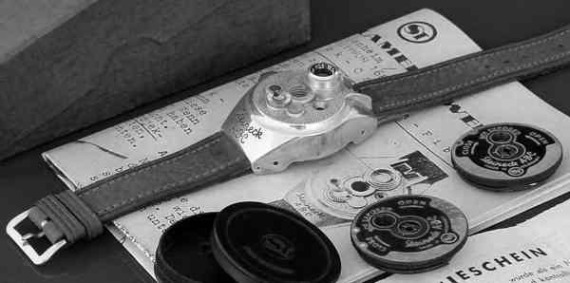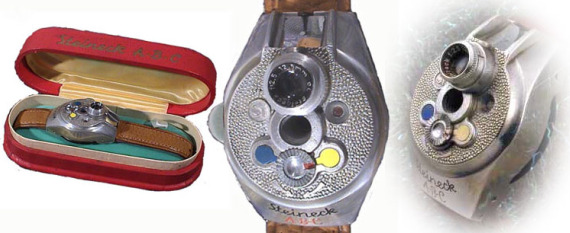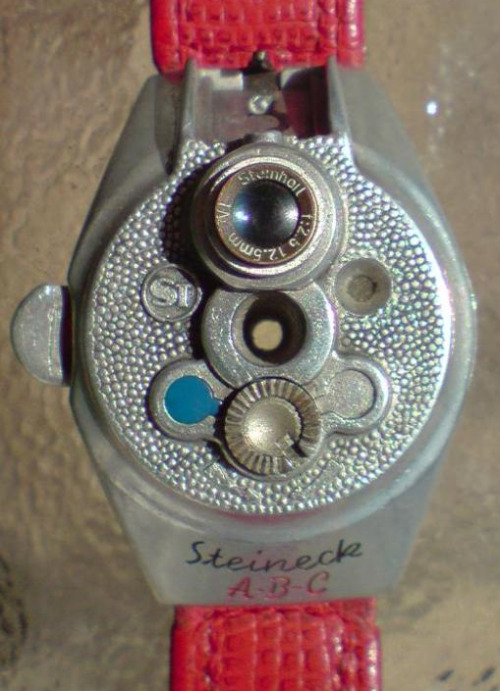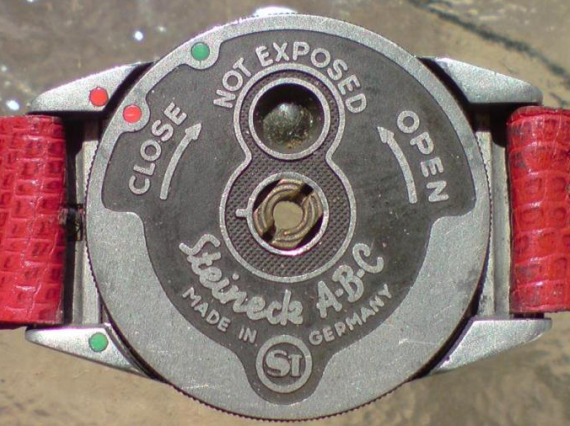

Still in Japan now, but I need to keep up the blogging else my loyal readers may violently demand I continue to write. I miss being at the computer, no worries about long pauses in content. While on my trip a reader pointed out this eBay auction for an interesting piece of watch and photographic history. It is the Stienbeck Kamerawerk A-B-C Camera watch from 1949. A fully functional worn on the wrist made over 50 years ago. I will republish a bit from the auction details to give you some of the nuts and bolts of this interesting item the banks on our love of spy gear, watches, and what looks to be a bit of the ol’ steampunk aesthetic.
I would call it a spy camera watch, but it was not meant to look like a regular watch. It was just a special wrist mounted camera that looked a lot like a watch. While it is hard to find the right film for it, it was made so that film from regular 35mm rolls of film could be used to make film for it. The watch for sale should still work, and is certainly a very cool collectors item. One sold for well over $2,000 over 10 years ago. The best part is the history. Meaning that it was actually popular back in the early 1950s among hobbyists and real detectives. Cool piece of watch and camera history. Here are some words directly from the eBay auction page:
“1949 Steineck Kamerawerk
Tutzing, West Germany
Lens: f2.5, 12.5 mm Steinheil, two aperture settings.
Shutter: Single speed, self-capping.
Construction: Metal body, Red leather strap.
Format: 8, 6 mm diameter exposures on a 25 mm diameter disc of film.
Focusing: Fixed.
Attributes: Curved mirror view-finder with pointer. Exposure counter.


The film is loaded into the removable back of the ‘watch’ and made light-tight by a rotating plate. Attaching the back to the camera rotates this plate and moves a circular aperture to lie behind the lens. When the release trigger is pressed a second plate in the camera rotates until an aperture is behind the lens, the shutter then operates. After exposure the plates returns, as it does, a spring loaded claw on the plate engages the film holder in the back and advances the film.
One of the longest running sales of a unique spy camera was the Steineck ABC Wrist Watch Camera. It was sold in the USA from the late 1940’s until the late 1950s. Although this was not a watch, and it really was not disguised, it was a highly popular camera for it’s time. If you were a private investigator and had one, you were the talk of the industry. No one, even to this day; quite knows why it was so popular but it was. Our guess is that it was just a show piece of modern camera technology for it’s time period.
(1949) Looks like a large wristwatch. Came with a 12.5mm (f2.5) fixed-focus lens. Single shutter speed. Eight round exposures with a 5.5 mm diameter are produced on a round disk of film 24mm in diameter. Disks can be cut from standard 35mm film. A cassette, with its own exposure counter, is used to hold the film. To load the camera, the cassette is pressed lightly into place in the opening in the back of the camera, and the knurled rim of the cassette is turned firmly to the right until it stops and the red dots on the camera body and cassette are aligned. Film advance is automatic — the film is readied for the next frame immediately after an exposure is made. The lens is a 12.5m f/2.5, made by Steinheil. It is fixed-focus so that everything from 4.25 ft. to infinity is sharp. The lens has a two-point aperture setting: one for bright light (red dot), the other for dim light (blue dot), set by a control knob on the face of the camera. The metal focal-plane shutter has only one speed, 1/125 sec. In making an exposure, the camera is held between the index finger and thumb, the shutter release being depressed by the thumb while the index finger serves to steady the camera by exerting a counter pressure. No separate action is required to advance the film or cock the shutter; as soon as the exposure has been made, the camera is ready to take the next picture. The A-B-C has two parallax-corrected finders: an optical hollow mirror viewfinder, which permits sighting from above when the camera, worn on the wrist, is held in picture-taking position. The other, a direct-vision viewfinder, is used at eye level, requiring that the camera be removed from the wrist. When the direct-vision finder is used, you sight through the hole in the back (cassette) with the camera close to the eye; the camera is held by the straps, both thumbs steadying the body, and the shutter release is operated by the index finger. The original accessories included filters, close-up lenses, and even a special enlarger. Steineck planned an M-sync flash for a future A-B-C, as well as a built-in filter carousel (to be put in front of the aperture control), and even a tripod-mount accessory that fits through the eye-level finder!”
This latter text is from the eBay auction page to help you understand the nature and function of the watch. I don’t know who wrote it exactly, but to check out the eBay auction you can check it out here:
Steinbeck ABC camera watch on eBay.